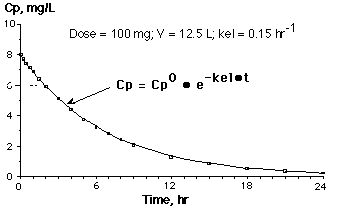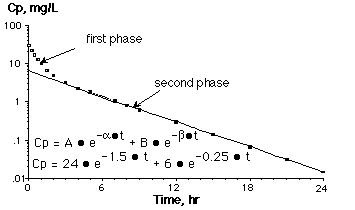Multi-compartment pharmacokinetic models
Objectives:
=> To draw the scheme and write the differential equations
appropriate to a multi-compartment pharmacokinetic model
=> To recognize and use the integrated equations for these models to
calculate parameter values and for dosage regimen calculations
=> To calculate the parameters of these models using the method of
residuals
=> To understand and use the non compartmental approach to
parameter estimation
So far we have talked about the pharmacokinetics of drugs in terms of a one
compartment model. We have assumed that the drug, once administered is mixed
instantaneously in the blood and that the drug distributes throughout the body
rapidly reaching equilibrium throughout the tissue into which the drug enters.
We have in essence considered that the body acts as a well mixed container.

Figure XIX-1 Linear Plot of Cp Versus Time for a One-Compartment - IV
Bolus
With first order drug elimination we found that the plasma concentration will
fall monoexponentially with time following IV bolus administration.

Figure XIX-2 Semi-Log Plot of Cp Versus Time
And the log of the plasma concentration will fall as a straight line.

Figure XIX-3 Semi-Log Plot of Cp Versus Time. Two-Compartment - IV Bolus.
Note Fast and Slow Processes
Commonly we find with real data, especially if we have a number of early data
points, that the log Cp versus time plot is not a straight line. We see an
initial early deviation from the straight line, followed by a log-linear phase.
The initial phase is a more rapid drop in plasma concentration before settling
into the log-linear fall in plasma concentration.
This suggests that the body is not behaving as a single well mixed
compartment. There appears, mathematically, to be distribution between two (or
more) compartments. That is we don't have instantaneous equilibrium between the
drug in all the various tissues of the body. In the next approximation we can
consider that the body is behaving as two distinct compartments. These
compartments can be called the central compartment and the peripheral
compartment. Exact anatomical assignment to these compartments is not always
possible. However, generally the rapidly perfused tissues often belong in the
central compartment.
|